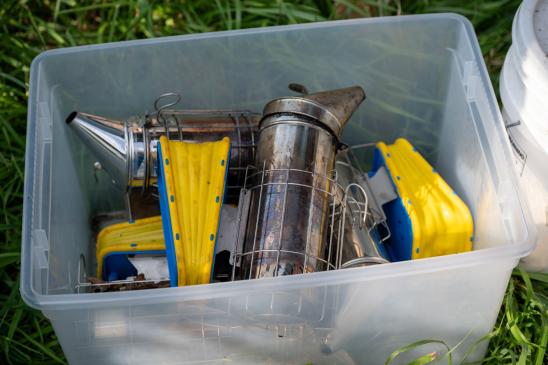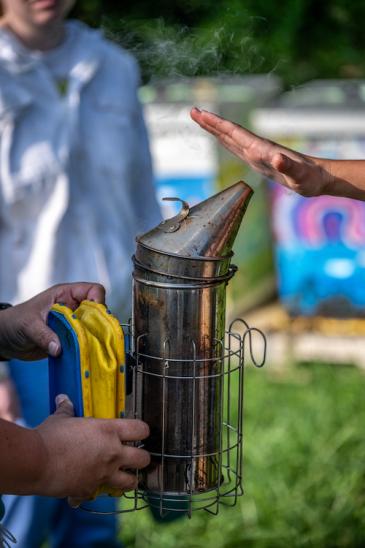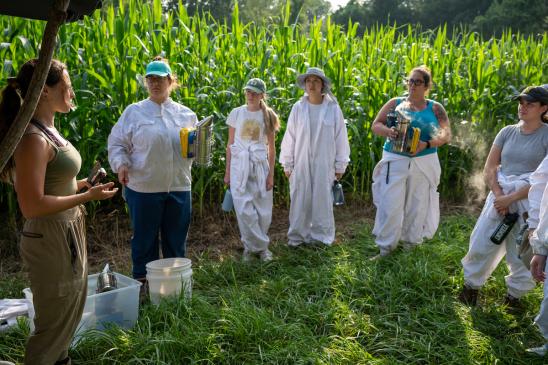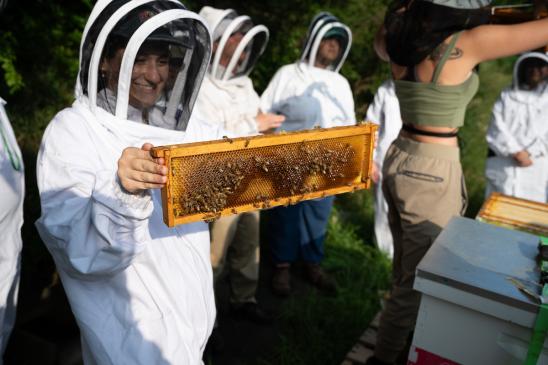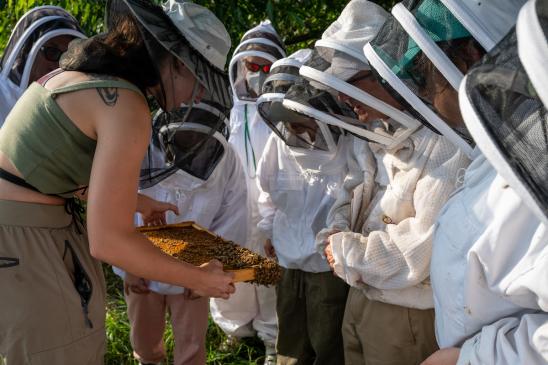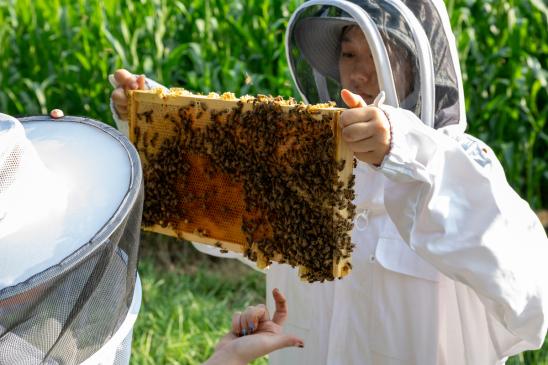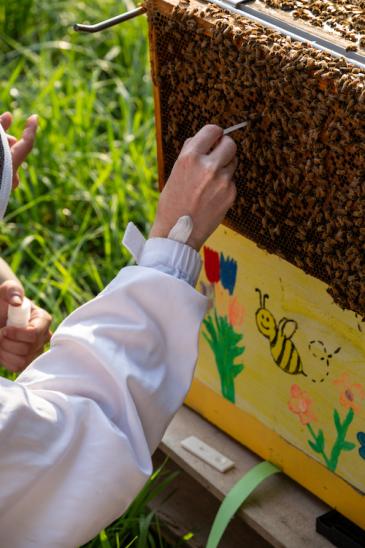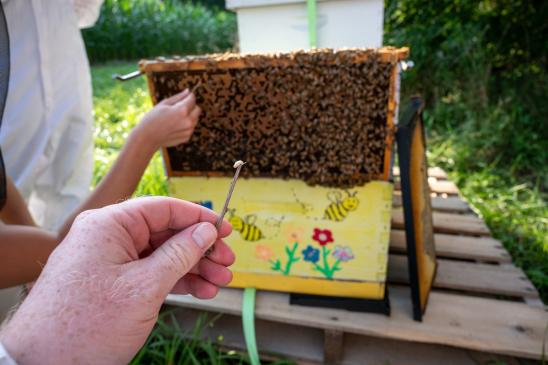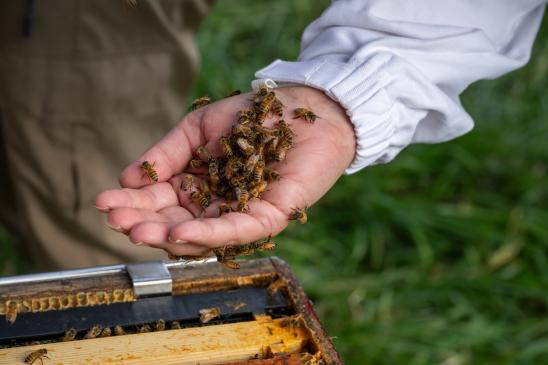-
About
- Leadership & Faculty
- News & Events
-
Academics
- Graduate
- Advanced Clinical Training
- Continuing Education
- Academic Departments
- Academic Offices
- Simulation Experiences
-
Student Life
- Offices
-
Research
-
Hospitals & Clinics
- Emergency Care
- Hospital Services
-
Community Outreach
- Volunteer
A Way to Bee
Join us for an inspection of Cummings School’s campus bee hives
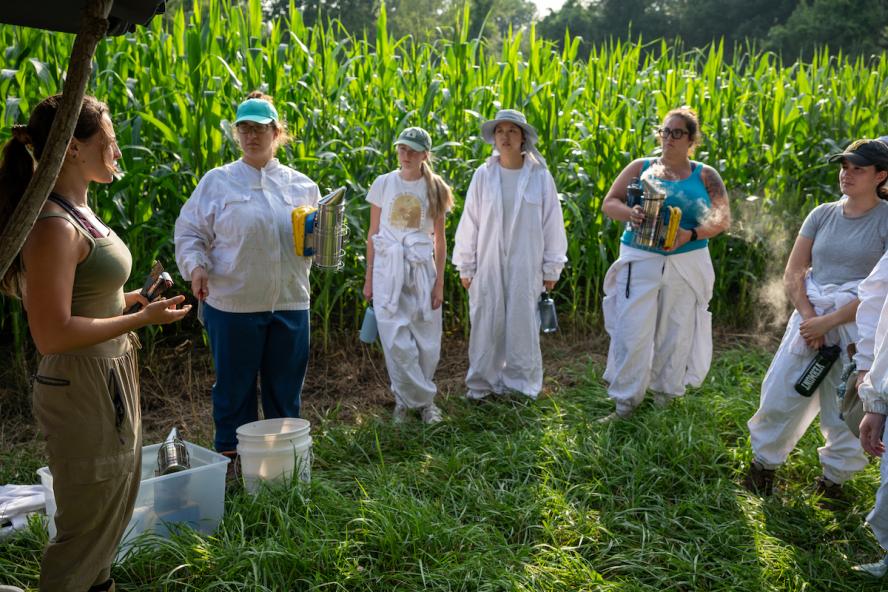
Cummings School of Veterinary Medicine’s beekeeping (apiary) project has been reignited by Courtney Wallner, V25, a former bee researcher and current veterinary student. She recently invited campus community members to learn about the school’s hives while assisting with a recent inspection.
Below is a photo recap of the group’s inspection, including Courtney’s explanations. All Photos: Jeff Poole, Cummings School of Veterinary Medicine
Above: Smokers are used to keep bees calm when they are upset. Although bees do not need to be smoked for each inspection, having a smoker nearby is good for practice and safety. Pine shavings are used for smoker fuel, however dried pine needles, non-nylon burlap, and other forms of kindling also work well.
Above: Smoking bees is very similar to using a chemical restraint in traditional veterinary species. The smoke can calm bees in two ways. First, when honey bees smell smoke, they are inclined to enter the hive and engorge themselves on honey. This is an instinctual behavior bees display to prepare for wildfires. Leaving your home and flying for many miles during a blaze is much easier with a full belly. For the beekeeper, however, it means the bees are less likely to be bothered when you enter their hive. The second way smoke calms bees is by blocking their alarm pheromone. Honey bees communicate extensively via pheromones. If one bee is upset, she immediately tells her sisters (all 60,000+ of them). Smoke can make it more difficult for bees to smell an alarm pheromone, thus keeping the beekeeper safe and more bees calm. The smoke’s temperature is tested with a bare hand. If it is too hot for a hand, it is too hot for the bees.
Above: Safety for beekeepers and the bees is always the first priority. Before opening the hives, participants are advised what to do if a bee ends up in your suit, if you get stung, or if you are being trailed by bees. Honey bees will die when they sting—the less they sting means less patients (the bees) pass away. Being gentle, patient, and showing respect for the bees’ limits keeps everyone safe.
Above: When honey bees are on a frame outside the hive for a long period of time, they tend to pool in the corners closest to the hive. They know the smell of their hive, their queen, and their sisters very well and will always head back to them.
Above: Apiary Manager Courtney Wallner shows students, technicians, clinicians, and other staff the “normals” and “abnormals” of a brood frame. This hive has European Foulbrood, a bacterial disease that affects developing baby honey bees. Being able to distinguish between healthy and unhealthy broods allow veterinarians to make accurate management recommendations, collect relevant samples, and evaluate the overall health of the hive.
Above: Knowing how to analyze a frame from a beehive is an essential part of a hive inspection. A thorough hive inspection tells a veterinarian the status of the hive in terms of health, queen status, and resources. This brood frame (a frame where the queen lays eggs) includes some honey flanking the top of it. It is being examined for the amount and quality of adult, pupa, and larval bees present, and the presence and age of eggs. All of these will lead to clues about the overall health of the colony.
Above: A spatula, small enough to fit in a ~0.47mm wide cell, is used to harvest a single larva for EFB (European Foulbrood) testing. The larvae harvested were chosen for sampling based on a few characteristics indicating it is likely sick. Amorphous shape, acrid odor, and a “mucus-like” appearance are all indicative of illness in honey bee broods.
Above: This is the result of a rope test performed on uncapped honey bee larval cells. Veterinarians perform this to test for foulbrood disease in honey bees. The bacterial foulbrood pathogens will liquify a developing honey bee larva (baby bee), causing it to stick to and “rope out” of the cell if something thin is inserted and removed slowly. The white, amorphous blob at the end of the stick is the sick bee larvae.
Above: Honey bees, one of only two domesticated insects, have been bred to be incredibly docile, gentle, and tolerant of human handling. Cummings School bees are of the Italian subspecies, or “breed,” Apis mellifera ligustica. Italians are known for their easy-going nature. Despite their ability to sting, the bees do not in most cases.
